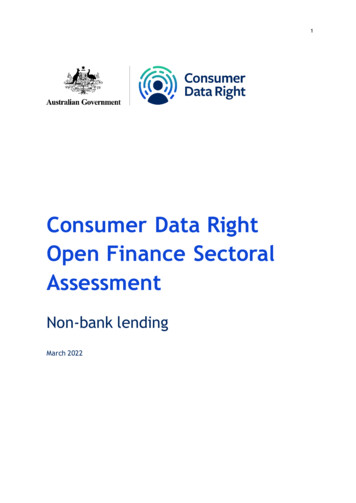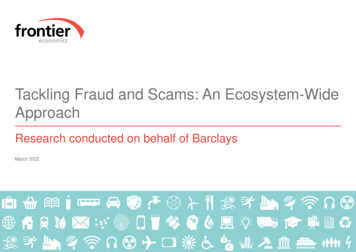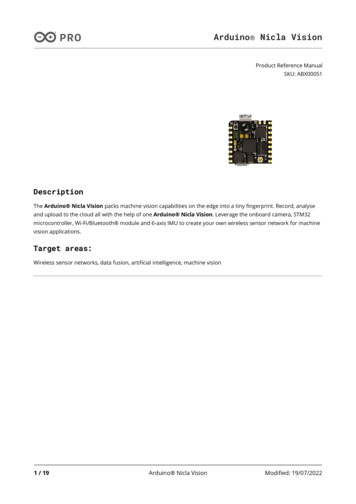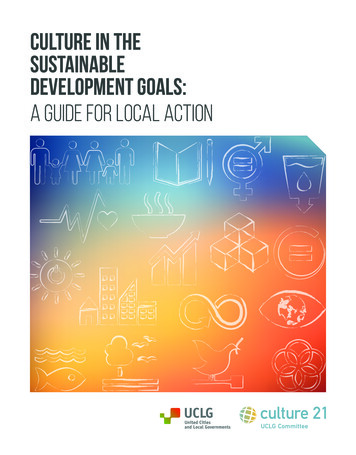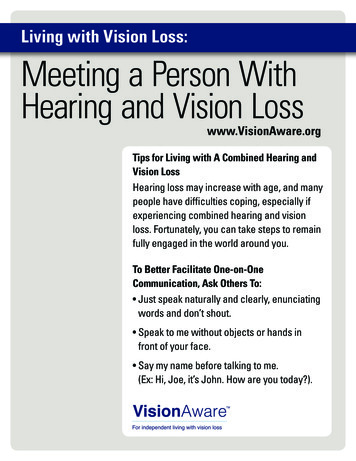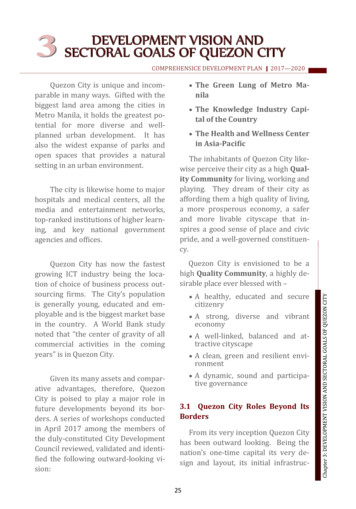
Transcription
DEVELOPMENT VISION ANDSECTORAL GOALS OF QUEZON CITYCOMPREHENSICE DEVELOPMENT PLAN 2017—2020The city is likewise home to majorhospitals and medical centers, all themedia and entertainment networks,top-ranked institutions of higher learning, and key national governmentagencies and offices.Quezon City has now the fastestgrowing ICT industry being the location of choice of business process outsourcing firms. The City’s populationis generally young, educated and employable and is the biggest market basein the country. A World Bank studynoted that “the center of gravity of allcommercial activities in the comingyears” is in Quezon City. The Green Lung of Metro Ma-nila The Knowledge Industry Capi-tal of the Country The Health and Wellness Centerin Asia-PacificThe inhabitants of Quezon City likewise perceive their city as a high Quality Community for living, working andplaying. They dream of their city asaffording them a high quality of living,a more prosperous economy, a saferand more livable cityscape that inspires a good sense of place and civicpride, and a well-governed constituency.Quezon City is envisioned to be ahigh Quality Community, a highly desirable place ever blessed with – A healthy, educated and securecitizenry A strong, diverse and vibranteconomy A well-linked, balanced and at-tractive cityscape A clean, green and resilient envi-ronmentGiven its many assets and comparative advantages, therefore, QuezonCity is poised to play a major role infuture developments beyond its borders. A series of workshops conductedin April 2017 among the members ofthe duly-constituted City DevelopmentCouncil reviewed, validated and identified the following outward-looking vision: A dynamic, sound and participa-tive governance3.1 Quezon City Roles Beyond ItsBordersFrom its very inception Quezon Cityhas been outward looking. Being thenation’s one-time capital its very design and layout, its initial infrastruc-25Chapter 3: DEVELOPMENT VISION AND SECTORAL GOALS OF QUEZON CITYQuezon City is unique and incomparable in many ways. Gifted with thebiggest land area among the cities inMetro Manila, it holds the greatest potential for more diverse and wellplanned urban development. It hasalso the widest expanse of parks andopen spaces that provides a naturalsetting in an urban environment.
QUEZON CITYtures and investments were orientedto serving a much wider constituencythan its local inhabitants. Therefore, itcannot afford to exist entirely for itselfeven after the national capital has beenexpanded into the entire Metro Manila,hence, the National Capital Region(NCR). As a city oriented to the outsideworld therefore, Quezon City does, orintends to project an ever wideningspiral of influence first to its immediate regional context – Metro Manila;then to the country as a whole; andfinally, to the growth continent of the21st century – Asia and the Pacific.Chapter 3: DEVELOPMENT VISION AND SECTORAL GOALS OF QUEZON CITY3.1.1 The Green Lung of the MetropolisThis is the unique role of QuezonCity being endowed with the most extensive expanse of open space andgreenery in Mega Manila. In relativeterms, open space takes up about onefifth of the total land area of the city.Considering that the city accounts forone-fourth of the metropolitan landarea its share of open space even inabsolute hectarage is unmatched byany other city. Contributing to thisgreen lung of the metropolis are largeparks which include the 2,570-hectareLa Mesa Reservoir and its watershedand the Quezon Memorial Circle andthe Ninoy Aquino Parks and Wildlifenature center with a combined area ofover 42 hectares. In addition, QuezonCity is host to huge university campuses such as those of the University of thePhilippines Diliman, Ateneo de Manila26University and Miriam College and recreational greens of major institutionssuch as Camp Aguinaldo, Camp Crame,Veterans Memorial Medical Center andthe privately-owned Capitol Hills Golfand Country Club and the QC SportsClub. Other linear parks of regionalimportance include easements of power transmission lines, center islandsand tree-lined boulevards and sidewalks provided with planting strips allwith an aggregate area of 57 hectares.Add to these the aqueduct right-of-waywith a total area of 65 hectares. Thesepatches of greenery in a vast metropolis provide a breathing space for theburgeoning population. These alsoprovide refuge to various wildlife thatmaintain a normal level of biologicaldiversity despite the constant threat ofcreeping urbanization.Between 2009 and 2016, the following conditions and development werenoted in relation to this component. Quezon City still has the largestshare of greenery to total land area,hence this role of the city is partlyattained. However, a decrease in thetotal area for open space from3,265.87 hectares (has) in 2009 to3,186.23 has in 2013 was observed. The La Mesa Watershed, as the lastremaining forest in Metro Manila, iscomposed of variety of ecosystemsand habitat to more than 170 species of Philippine flora and fauna. Todate, 72 endemic tree species havebeen planted by a total of 20,000
COMPREHENSICE DEVELOPMENT PLAN 2017—2020velopment and access of these nature parks and center. Opportunities for other green areas are limited and the existing green spacesare invaded by concrete surfaces;natural drainage corridors are taken over by residential use, particularly by informal settler families(ISFs), lack of fresher concepts inparks and lack of ample accessibilitymechanisms in the parks and openspaces especially for the elderly andpeople with disabilities.volunteers in 1,344 has. of the watershed. The 30-hectare La MesaEcopark Resort’s amenities includean Orchidarium, Butterfly Garden,Hanging Bridge, picnic area and ecotrails. The Quezon Memorial Circle is one The city has partially fulfilled therole to take the lead in the numberof green legislations enacted andimplemented as the current administration has been a pioneer andprogressive advocate of solutionsfor environmental issues, climatechange and sustainable solutions.Moreover, it has enacted severallaws on environment protectionsuch as the Environmental Protection and Waste Management Codeof Quezon City in 2014. It is the firstcity in the entire country to implement a Green Building Ordinance.The city has adopted various goodgreen practices such as: the establishment of materials recovery facility (MRF) where collected garbage are sorted properly; an effective information campaign on thepractice of 3Rs or Reduce, Reuse,and Recycle; and, a green publictransport system has been initiated The Ninoy Aquino Parks and Wild-life Nature Center is the only zoological and botanical garden located atthe southwest of the QMC whichhouses 38 species of trees andshrubs in 2009 represented by2,443 trees commonly found in Philippine forests and has kept variousspecies of endemic and endangeredbirds, mammals, reptiles and amphibians in the open-air Mini-zooand Wildlife Rescue Center. It further serves as venue for public education, and training and researchfacility for future veterinarians andbiologists. It also includes otheramenities like cottages available forconferences, meetings, seminars,children’s playground, visitor’s center, a man-made lagoon for fishing, arock garden and a craft village. The city also faces some challengesin the continued maintenance, de-For Quezon City to maintain thisrole in the metropolis in the long term,it shall see to it that:a)it accounts for the largest share ofgreenery to total land area and main27Chapter 3: DEVELOPMENT VISION AND SECTORAL GOALS OF QUEZON CITYof the most visited parks in the citywith a recorded number of1,105,118 visitors from 2006 –2008. The proliferation of an increasing number of commercialspaces, if continued and unregulatedwill undermine the function of thepark and open space. There is noclear mechanism for encouragingand recording the number of visitors from different cities.
QUEZON CITYtains the most extensive proportion ofopen space and greenery with the consideration that: the 25% open spaceand greenery will be retained with anincrement of 1 % - 5% annually; some5% will be allocated to businesses andvendors; and, convert portions foramusement areas and wellness or fellowship programs for citizens of thecity and the metropolis.Chapter 3: DEVELOPMENT VISION AND SECTORAL GOALS OF QUEZON CITYb) its well-tended parks are patronized by the metropolitan populationthrough a clear public informationcampaign; development of these areasas eco-tourism areas; and budget allocation for the maintenance and development of these nature parks and centers.c) it encourages relevant researchand development activities and planning projects that will preserve theopen spaces and greenery in the campuses and major public and privateinstitutions.d) it explores renewable energysources in the university campuses andmajor institutions with big reserves ofrecreational greens that the City hosts.it develops linear parks/open spaces inall barangays, in areas cleared by thePasig River Rehabilitation, and in thePayatas Dumpsite.e) it continues to keep the lead inthe number of green legislation enacted and implemented.3.1.2 The Country’s KnowledgeIndustry CapitalQuezon City’s claim to this role isboosted by the presence of top ranked28universities and other institutions ofhigher learning. It has been cited alsoas among the top 50 emerging globaloutsourcing cities, a definite advantagethe city has now attained in the information and communication technology(ICT) industry. Moreover, Quezon Cityis home to all national television andmovie production outfits and university-based facilities for visual and performing arts. But more than the passive role of providing sites and venuesfor the production and application ofknowledge, Quezon City intends to beactively engaged in the promotion, enhancement and preservation of thesciences and the arts.From the time this vision was crafted, the following conditions and development were observed in relation tothe second component, which reflectsomething to be desired in fulfillmentof such vision: While the City hosts top rankeduniversities and other institutionsof higher learning, it lacks programto recruit other top ranked universities and the city university, Quezon City Polytechnic University(QCPU) would benefit from moregovernment support. The QC is the leading LGU in termsof land area occupied (260.3 has.)for ICTs. It is however next to Makati City in terms on the number ofICT companies (52 in QC, 64 in Makati City). If this is not aggressivelysustained and expanded through
COMPREHENSICE DEVELOPMENT PLAN 2017—2020 The City is still home to all nationaltelevision and movie productionoutfits and university-based facilities for visual and performing arts.Aggressive feedbacking and consultation mechanism will be helpful to prevent relocation and tosustain these facilities’ stay in Quezon City.There is lack of LGU attention asevidenced by lack of major program launched and budget for azoned knowledge industry precinctto house the community of researchers and innovators and toshowcase new products and processes.As identified in 2009, indicatorsthat Quezon City is truly performing itsrole as the knowledge industry capitalof the country include that the following facilities, events and programs area regular fare in the city. This sectionreviews what . have been achieved inrecent years and what more can bedone to fulfill these indicators. Research institutes in variousfields of knowledge establishedWith the City’s booming ICT industry, 14 ICT schools and tertiary leveleducation facilities of top-notch educational institutions such as 268 trainingcenters and research institutes are inplace. There are some tie-ups in specific areas of research, such as on greenbuilding technology. The Bureau ofAgricultural Research, Philippine Nuclear Research Institute and the Southeast Asian Ministers of Education Organization (SEAMEO) Regional Centerfor Educational Innovation and Technology (INNOTECH) are some of theexisting research institutes. There ishowever much to be desired in theprovision/program to relocate research institutes in QC and collaborative works with these already existingfacilities. City-funded scholarship grants forpost-graduate studies available forcompetition among qualified candidates nationwideCity-funded post-graduate studiesgrants are not yet offered city-wide,much more nationwide. These requirehigh educational requirements andstandards. Such is being overtaken bychallenges of unemployment, lack ofemployment opportunities and lack ofestablishments for job creation. Museums, art galleries, libraries andtheaters for the performing arts putup by the city independently of theuniversities’ ownIn November 2015, the Quezon CityExperience (QCX) an interactive "socialhistory museum” that allows visitorsto learn more about the history andculture of the sprawling city opened atthe Quezon Memorial Circle. Government and private sector participationcan be enhanced in the establishmentof more of these facilities.29Chapter 3: DEVELOPMENT VISION AND SECTORAL GOALS OF QUEZON CITYvarious programs to attract investors, other cities like Makati andTaguig might overtake the role ofQuezon City as among the emerging global outsourcing cities.
QUEZON CITY Regular arts and sciences events suchasconferencesandseminarworkshops held with personalities ofinternational and national renown inattendanceWhile the Araneta Coliseum wasidentified as a regular venue, there isstill a lack in big venues available forsuch events.Much has to be done in the followingindicators: City-sponsored awards and recogni-tion for outstanding Filipino scientists and inventors and artists conducted at least during jubilee anniversariesChapter 3: DEVELOPMENT VISION AND SECTORAL GOALS OF QUEZON CITY Balikbayan programs for foreign-based Filipino name artists and scientistsIn addition to these previous indicators, the CDC workshop identified additional success indicators such as: Improvement and promotion of tourist spots and Installation of solar power in IT facilities.3.1.3Healthcare and WellnessCenter in Asia-PacificThis is an emerging role of QuezonCity. The city already boasts of thebest medical facilities and services, theproliferation of wellness centers, physical fitness centers, health clinics, pharmaceutical, food, beauty and sanitaryproducts, caregiving schools, laborato30ries, medical transcription firms, andthe presence of the most advanced andspecialized hospitals. Fully endorsedby the private sector and supported bythe local government, the healthcareand wellness industry is bound toflourish for the benefit of a wide ranging clientele locally and abroad.The recent plenary workshop withinthe City Development Council expanded the geographical scope from Asia toAsia-Pacific because of the number oftourists who come from the Pacific forhealthcare services.From 2009, when this vision component was identified, the city had implemented the following: Essential Health Care Package in 64Health Centers Ambulatory care by the two (2) gov-ernment hospitals Promotion of healthy lifestyle Health programs and services ofpublic and private health facilities Subsidy for medicines by the localgovernment and DOH Medicine package provided to thecity’s senior citizens and indigents Health facilities such as seven (7)super health centers, 53 regularhealth centers and 13 sub-health stations , dialysis centers, lying in clinics, dental clinics and other privatehealth and wellness facilitiesHowever, despite the envisionedhealthcare and wellness industry asthe city’s signal product under the One-Town-One-Product (OTOP) program
COMPREHENSICE DEVELOPMENT PLAN 2017—2020Too, while the previous plan identified the establishment of ‘hospitels’ asa support to the city’s being a healthand wellness hub has not beenachieved. In fact, none of the existing64 hospitals –18 government and 46private have put up hospitels. The enhancement/upgrading of existing private and public facilities, equipment,and medical services are being prioritized by hospital owners rather thanputting up hospitels.Also, there are observed apprehensions on the part of investors due inpart to the unclear benefits/incentivesthat can be derived in putting up hospitels. Other factors noted, despitesome proposals are being processed,were: lack of coordination amongstakeholders in both public and privatesectors; not a priority and no resourceallocation on the part of the city government; lack of promotion.In the future, the following additionalfacilities and services are to beachieved in order for Quezon City torightfully claim this vision: Medicines and health services withinreach of the poor, retirees, elderlyand differently abled persons Health/medical tourism flourishing World class pet care facilities for useby local pet lovers and visitors alike.3.2 Quezon City as a Desirable Human SettlementThis inward-looking component ofthe city’s vision describes the desiredcharacteristics of the city as a place inwhich to live, work and play. Suchcharacteristics are expressed in termsof choice descriptors for the desiredkind of citizens, the local economy, thebuilt and unbuilt environment and theinstitutions for the city’s governance inthe future. Each descriptor is furthertranslated into success indicators tofacilitate monitoring of progress at anytime in the future.3.2.1 Desired Qualities of the CitizenryIn order to attain a high QualityCommunity the city must have ahealthy, educated and secure citizenry.1) A HEALTHY citizenry is characterized by the following: Hospitals that double as hotels or ”hospitels” Health and scientific conferences regularly hosted by the city 31Morbidity rates reduced tothe minimumMortality rates at normal levelsHealth insurance for all families providedAll households have sanitaryChapter 3: DEVELOPMENT VISION AND SECTORAL GOALS OF QUEZON CITYof the Department of Trade and Industry (DTI), this has not been realizedyet. This has to be in the agenda of relevant city offices and industry as thiscan build up a critical mass of factorendowments to propel it towards becoming the premier hub of healthcareand wellness in Asia-Pacific.
QUEZON CITY toilet facilitiesAll households have access tosafe and potable waterIncidence of malnutritioneradicated2) An EDUCATED citizenry can beobserved or inferred when: Chapter 3: DEVELOPMENT VISION AND SECTORAL GOALS OF QUEZON CITY 100% literacy rate is achievedAll school-age population arein school including differentlyabled persons who are provided appropriate educationEnrollment participation rateincluding SPED enrollees atmaximum levelCohort survival rate at optimum levelDropout rate reduced to zeroExcellent academic performance in all basic levels of education achievedIdeal classroom-student ratiomet (1:50)Ideal teacher-student ratiomet (1:50)Training Centers & ResearchInstitutes established and well-maintainedPublic school teacher competence at par with or betterthan those of leading schoolsStandard book-student ratioattainedScholarship grants for tertiaryeducation to post graduatestudy sustainedCulture and arts developed,preserved and patronized323) A SECURE citizenry is shown byor assured of the following: Zero crime rateCrime solution efficiency ratehigher than that in Metro ManilaDrug abuse eliminatedStandardpolice-populationratio attained (1:500)Fire-free cityStandardfirefighterpopulation ratio attained(1:2000)Standard fire station-land arearatio met (1:4 sq.km.)Standard jailguard-inmate ratio met (1:7)Standard inmate-cell spaceratio met (1:4.70sqm)Decent and affordable housingfor all providedFamilies in all danger areasrelocated to hazard free areasInformal settlers assured ofsecure tenure in land anddwellingsStandard Day Care CenterPupil ratio met (1:25)Standard Day Care Worker –Pupil ratio met (1:25)Children in need of specialprotection (CNSP) are caredforYouth sector assisted and protectedPersons with disabilities assistedWomen served and assistedElderly assisted and protectedSolo-parent care provided
Standard social worker-clientratio achieved: (Center based1:15, Community based 1:60) Of the three descriptors of the desired attributes of Quezon City’s citizens, that of being secure, both in theirpersons and their communities seemsto be the ultimate goal. Even the otherqualities of being healthy and educatedcontribute to the citizens’ ultimate security. 3.2.2Desired Character ofthe City’s Economy A local economy that is diverse,strong and vibrant ensures prosperityand sustainable growth for all. To attain this goal the following success indicators were set : 1) DIVERSE : The local economyis said to be diverse/diversified whenit exhibits the following characteristics: QCis functioning as“Wellness Capital of Asia-Pacific” asshown by Tertiary hospitals with ISO ac-creditation Hospitals, health spas, specialtyclinics (with high service quality standard) in abundance Well implemented Health/Medical Tourism program World class training for healthworkers QC is truly the Knowledge Industry Capital of the Country Number 1 in terms of number33of firms and area coverage devoted to IT activitiesNationally and internationallyrecognized training institutions providing IT solutions /servicesAs wi-fi enabled areaFocused area for high-end information technology businessesAccess to high quality education for allNurture systems for the giftedare in placeSkilled manpower and humanresources are utilizedTertiary level education facilities (top notch educational institutions), training centersand research institutes in placecholarship grants for advancedstudies sustainedPreservation of culture andartsMuseums and galleries andpublic libraries established andmaintainedHistorical sites preservedBalikbayan program for foreign based Filipino artists implementedBooming ICT (No. 1 in thecountry’s ICT industry)Support for investors and innovatorsBalikbayan program for foreign-based Filipino scientistsRegular arts and science conferences and competitionsWorld class facilities in entertainment, sports and performing arts establishedChapter 3: DEVELOPMENT VISION AND SECTORAL GOALS OF QUEZON CITYCOMPREHENSICE DEVELOPMENT PLAN 2017—2020
QUEZON CITY Ideal site for business invest-ments both for the Service Sector (wholesale and retail,transport, storage and communication, real estate, hotel andrestaurants, financial institutions, health, education, etc.)andIndustrySector(manufacturing, construction,electric, gas and water) Leading tourist destination inMetro Manila catering to various types of tourists (local andforeign) in fields of medical,educational, political, business/investors, etc. A culinary tourism destinationChapter 3: DEVELOPMENT VISION AND SECTORAL GOALS OF QUEZON CITY2) STRONG : A strong (malakasat matibay) local economy can be seenor inferred from the following indicators: Site for the leading businesses in the countryLocally produced products andservices developed, promotedand distinctly branded as QCAbundant supply of food andcommodities that are affordable to allFully employed human resources (with skills relevant tothe needs of the industry)Reduced unemployment rate toa single digitReduced poverty incidence tolevels below the national levelQC as no. 1 in business tax collection in the countryInstitutionalized cooperation /partnership between the cityand private sector / NGOs34 Productive and properly regu-lated informal sector3) VIBRANT: A vibrant (masiglaat matiwasay) local economy is thegeneric descriptor of a diverse andstrong economy. It is attained whenthe following indicators can be observed: QC as a globally competitive growth centerLow cost of doing businessSkilled and abundant humanresourcesWell placed infrastructure support facilitiesResponsive government tobusiness needsHealthy and peaceful businessenvironmentSustained growth in new andold investmentsNear-zero incidence of business closuresSteady increase in businessstart-ups3.2.3 Desired Quality of the EnvironmentA clean, green and resilient environment is conducive to healthy cityliving and is attractive not only to thelocal residents but also to visitors.In order to determine success inachieving this goal, certain indicatorswere set to measure performance invarious areas of concern.1) The city is successful in beingCLEAN when, in terms of:
COMPREHENSICE DEVELOPMENT PLAN 2017—2020 Promoted popular/wide use ofSolid Waste Its surroundings are garbage free Its solid waste generated/disposed daily is reduced to50% Residents are using ecologically-sound practices Disposal of toxic, hazardousand healthcare wastes properlyregistered and monitored Air Quality Ambient air is maintained atlevels within EMB standards(TSP level-90 mg/cu.m)Water Qualitytained at levels within EMBstandards (BOD-7 mg/l belowand DO – 5 mg/l up) Controlledand minimizedgroundwater extraction3) The city has a RESILIENT environment when Exposed communities are pro-tected from natural and manmade hazards. Its residents are adequatelyprepared to handle disastersand mitigation measures are inplace The city government can effectively address and efficientlymanage all types of emergencies2) The city shall be known as theGreen Lung of the metropolis. Its environment is GREEN when it has Thelargest percentage ofgreenery to total land areaamong component LGUs inMetro Manila Recovered, restored, developedand protected its easementsand open spaces for the public An inter-connected system ofparks, green areas and openspaces A well-protected and preservedwildlife3.2.4 Desired Character of the BuiltEnvironmentA well-linked, balanced and attractive cityscape makes city livingpleasant and enjoyable.35Chapter 3: DEVELOPMENT VISION AND SECTORAL GOALS OF QUEZON CITY Surface water quality is main-renewable energyAccess to and wide use of alternative fuelsGreenpedestrian-friendlythoroughfaresThe largest number of greenlegislations enacted and implementedIts parks are well-patronizedby local and metropolitan residents alikeAll its barangays have accessible and resident-friendly parksPeople and all sectors areproud of their environmentand are actively engaged in itscare, protection, preservationand promotion
QUEZON CITYThis goal is said to be attainedwhen the following success indicatorsare observed to be existing:WELL-LINKED : The city is welllinked externally and internally when An observed inter-connectedhierarchy of roads and streetsATTRACTIVE : The city appearsattractive when All-weather roads and bridgesare properly constructed andmanaged Roads/travelling comfort formotorists and commuters Walking and other non-motorizedmodes of mobility can be used Chapter 3: DEVELOPMENT VISION AND SECTORAL GOALS OF QUEZON CITY safelyAdequate parking areas, loading and unloading zones areprovidedMass transit systems are inplaceUtilities are installed undergroundUnderground mass transit system/monorail are in place Effective drainage and sewerage systems are installedBlighted areas are redevelopedOpen spaces within the builtup areas are greened and developedUrban landscape is l sites and landmarks arepreserved and maintained3.2.5Desired Qualities ofLocal GovernanceA dynamic, sound and participative governance contributes to thecity’s effort in building a high QualityCommunity.1) DYNAMIC governance is indicated by : InnovativeBALANCED : The landscape isbalanced when Built-up areasare integratedwith the city’s open spaces Standards on open spaces requirement are complied with Urban development is distributed in self-contained communities Adequate urban expansion areas are available36 systems(management systems, operations and communication systems) institutionalizedClear Organizational StructureComprehensive Human Resource Development ProgramComprehensive Manual of Operations for the whole City BureaucracyAn approved plantilla for thebureaucracyPromotion of Teamwork in Executive
COMPREHENSICE DEVELOPMENT PLAN 2017—2020and well-trained3) There is PARTICIPATIVE governance when- Adequate data base to support Citizens’ participation in pro- Competentemployeesgrams and projects is institutionalized There is strong linkage or partnership with the NGOs/POs,academe, research and traininginstitution, etc., at the city andthe barangay level Information on plans, programs and activities are accessible (transparency) to allstakeholders Venues for airing complaintsor grievances are available the plan Professional attitude and behavior of leaders Governance and leadershiprecognized by internationalandnational award-givingbodies as well by the City to itsbarangays2) Fiscal management and locallegislation are SOUND when Fiscal Management Revenue generation increases Chapter 3: DEVELOPMENT VISION AND SECTORAL GOALS OF QUEZON CITY progressively (RPT, businesstax)City finances are relatively selfreliantResources are utilized based onthe community’s need and requirementGraft and corruption is reducedto zero100% compliant with mandatory/statutory obligationsLocal Legislation Adequate and appropriate localordinances are enacted andare properly implemented bythe Executive There is active stakeholdersand people participation in legislation and policy formulation Strong coordination betweenthe Legislative and Executivebranches of the LGU exists37
City being endowed with the most ex-tensive expanse of open space and greenery in Mega Manila. In relative terms, open space takes up about one-fifth of the total land area of the city. Considering that the city accounts for -fourth of the metropolitan land area its share of open space even in absolute hectarage is unmatched by any other city.

